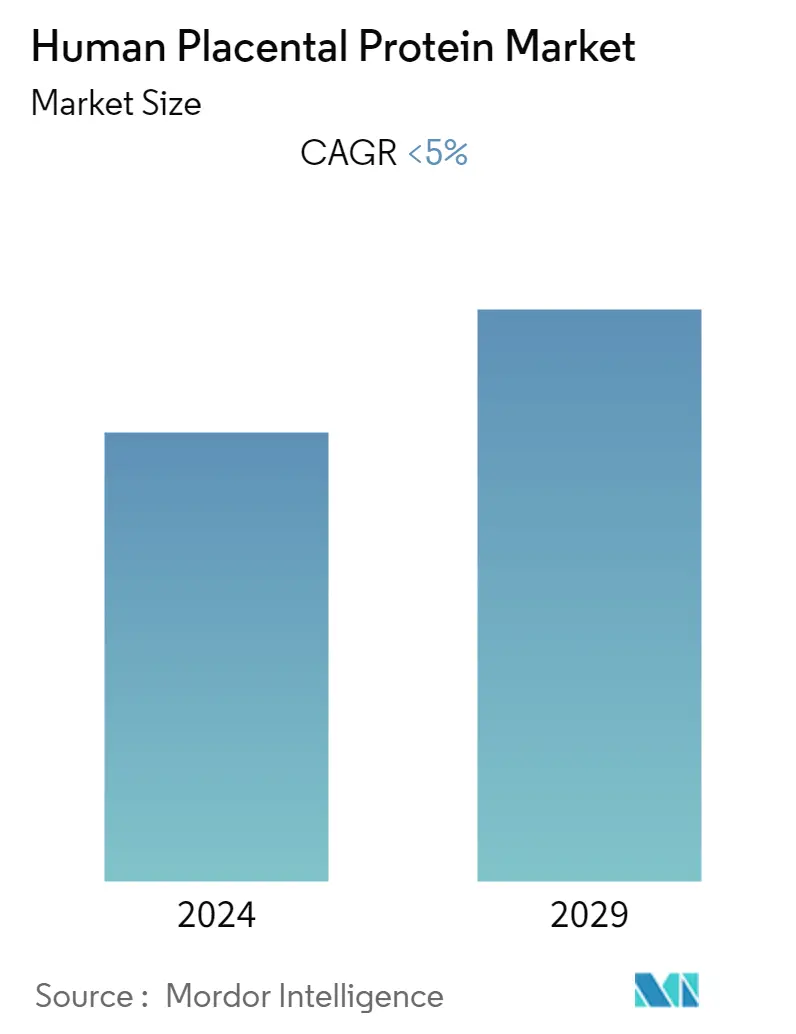Market Size of Human Placental Protein Industry

| Study Period | 2019 - 2029 |
| Base Year For Estimation | 2023 |
| Forecast Data Period | 2024 - 2029 |
| CAGR | < 5.00 % |
| Fastest Growing Market | Asia Pacific |
| Largest Market | North America |
Major Players
*Disclaimer: Major Players sorted in no particular order |
Human Placental Protein Market Analysis
The Human Placental Protein Market is expected to register a CAGR of around 5% during the forecast period. Rising use of placental protein in cosmetics and medication to treat menopause is among the key factor triggering the growth of the human placental protein market. For instance, several products are in the human placental market which is promoting the revenue growth, Melsmon pharmaceuticals are producing pharmaceutical-grade placenta which is used for treating menopause. In addition, Japan Bio Products has Laennec which treats chronic hepatitis and another company Alber David has Inj.Placentrex. (wound healer).
The increase in R&D investments in healthcare coupled with the introduction of human placental protein in pseudo-medicines will create lucrative opportunities in the human placental protein market.
However, prolonged use of human placental proteins can cause skin dryness which hampers the market.
Human Placental Protein Industry Segmentation
As per the scope, Human placental protein includes protein derived from human placentas used in several applications such as luteotropic, lactogenic, cosmetics and growth-promoting action. Human Placental Protein Market is segmented By Type, Application, and Geography.
| By Type | |
| Hydrolyzed Human Placental Protein | |
| Human Placental Enzymes | |
| Others |
| By Application | |
| Tumor markers | |
| Life sciences | |
| Others |
| Geography | ||||||||
| ||||||||
| ||||||||
| ||||||||
| ||||||||
|
Human Placental Protein Market Size Summary
The Human Placental Protein Market is poised for steady growth, driven by its increasing application in cosmetics and medical treatments, particularly for menopause. The market is witnessing a surge in demand for products like those from Melsmon Pharmaceuticals, which offers pharmaceutical-grade placenta for menopause treatment, and Japan Bio Products' Laennec for chronic hepatitis. The market's expansion is further supported by rising investments in healthcare research and the incorporation of placental proteins in pseudo-medicines, presenting lucrative opportunities. However, challenges such as skin dryness from prolonged use of these proteins may hinder market growth. Skin care products are anticipated to lead the market, fueled by the growing popularity of cosmetics and the expanding menopausal population. The nutritional benefits of placental proteins, derived from their role in fetal development, are being harnessed in various skincare and hair care treatments, contributing to the market's expansion.
Regionally, North America is expected to capture a significant share of the global market, attributed to its aging population and a higher incidence of menopause. The adoption of placental extracts for menopausal treatment is on the rise, supported by increased healthcare spending and robust healthcare infrastructure. The market is moderately competitive, with local players from various countries making notable contributions. Key companies gaining attention include JAPAN BIO PRODUCTS Co., Ltd., VWR International, Takara Bio Inc, Abcam plc, Kamiya Biomedical Co, Scripps Laboratories, and Lee BioSolutions. These companies are instrumental in driving the market forward, leveraging the growing demand for human placental protein in both therapeutic and cosmetic applications.
Human Placental Protein Market Size - Table of Contents
-
1. MARKET DYNAMICS
-
1.1 Market Overview
-
1.2 Market Drivers
-
1.2.1 Increasing use of Cosmetics Products
-
1.2.2 Increasing Ageing Population
-
-
1.3 Market Restraints
-
1.3.1 Adverse Effects
-
-
1.4 Porter's Five Force Analysis
-
1.4.1 Threat of New Entrants
-
1.4.2 Bargaining Power of Buyers/Consumers
-
1.4.3 Bargaining Power of Suppliers
-
1.4.4 Threat of Substitute Products
-
1.4.5 Intensity of Competitive Rivalry
-
-
-
2. MARKET SEGMENTATION
-
2.1 By Type
-
2.1.1 Hydrolyzed Human Placental Protein
-
2.1.2 Human Placental Enzymes
-
2.1.3 Others
-
-
2.2 By Application
-
2.2.1 Tumor markers
-
2.2.2 Life sciences
-
2.2.3 Others
-
-
2.3 Geography
-
2.3.1 North America
-
2.3.1.1 United States
-
2.3.1.2 Canada
-
2.3.1.3 Mexico
-
-
2.3.2 Europe
-
2.3.2.1 Germany
-
2.3.2.2 United Kingdom
-
2.3.2.3 France
-
2.3.2.4 Italy
-
2.3.2.5 Spain
-
2.3.2.6 Rest of Europe
-
-
2.3.3 Asia-Pacific
-
2.3.3.1 China
-
2.3.3.2 Japan
-
2.3.3.3 India
-
2.3.3.4 Australia
-
2.3.3.5 South Korea
-
2.3.3.6 Rest of Asia-Pacific
-
-
2.3.4 Middle-East and Africa
-
2.3.4.1 GCC
-
2.3.4.2 South Africa
-
2.3.4.3 Rest of Middle-East and Africa
-
-
2.3.5 South America
-
2.3.5.1 Brazil
-
2.3.5.2 Argentina
-
2.3.5.3 Rest of South America
-
-
-
Human Placental Protein Market Size FAQs
What is the current Human Placental Protein Market size?
The Human Placental Protein Market is projected to register a CAGR of less than 5% during the forecast period (2024-2029)
Who are the key players in Human Placental Protein Market?
Takara Bio Inc, VWR International, Scripps Laboratories, Lee BioSolutions and JAPAN BIO PRODUCTS Co. are the major companies operating in the Human Placental Protein Market.

